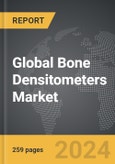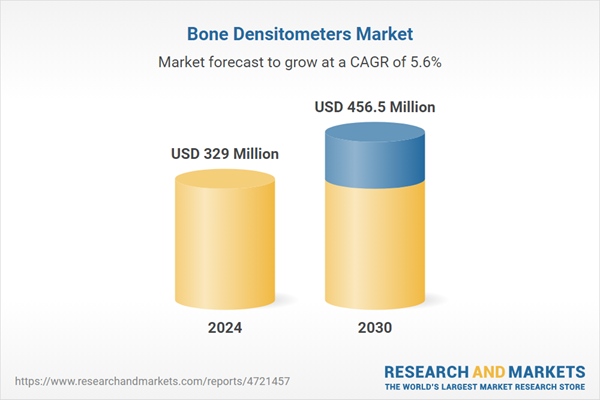The global market for Bone Densitometers was valued at US$329.0 Million in 2024 and is projected to reach US$456.5 Million by 2030, growing at a CAGR of 5.6% from 2024 to 2030. This comprehensive report provides an in-depth analysis of market trends, drivers, and forecasts, helping you make informed business decisions. The report includes the most recent global tariff developments and how they impact the Bone Densitometers market.
This has expanded the market for bone densitometers. Technological advancements have also improved the accuracy and efficiency of densitometers, making them faster and easier to use, with user-friendly interfaces and better imaging quality. In emerging markets, the adoption of bone densitometers is on rise due to improved healthcare infrastructure, increasing awareness, and the growing burden of osteoporosis. There is also a growing focus on preventive healthcare, which has driven routine bone density testing as a strategy to identify and treat bone-related conditions early.
Recent trends in bone densitometers include the development of portable and lightweight devices that offer convenience and versatility in clinical and field health assessments. Digital bone densitometers equipped with 3D imaging technology provide more detailed and accurate results, offering comprehensive analyses for healthcare professionals. Integrated software solutions help densitometers analyze patient data, monitor changes over time, and predict fracture risks. Furthermore, new devices can measure additional health parameters beyond bone density, such as muscle mass and body composition, offering a more comprehensive assessment.
The field of bone densitometry is rapidly evolving, incorporating new technologies and methodologies that provide a more comprehensive understanding of bone health and fracture risk. As these technologies advance, they not only enhance the accuracy of osteoporosis diagnoses but also broaden the scope of bone health assessment, paving the way for more effective prevention and treatment strategies. This progress underscores the dynamic nature of bone research and its critical role in improving patient outcomes in osteoporosis and other bone-related conditions. Recent advancements have enriched the methodologies available for evaluating bone fragility. The DXA-3D technique which reconstructs three-dimensional models of bone density from two-dimensional DXA images provides detailed assessments of the internal density of the femur, potentially offering new insights into the structural and mechanical strength of bone beyond what traditional DXA scans can provide. High-resolution peripheral quantitative computed tomography (HR-pQCT) and densitometric vertebral fracture assessment (VFA) are other innovative approaches.
Artificial intelligence and machine learning are being incorporated to improve workflow efficiency and provide consistent diagnoses through pattern recognition. This trend has led to better workflow management and greater diagnostic accuracy.
Segments: Segment (Axial Bone Densitometers, Peripheral Bone Densitometers).
Geographic Regions/Countries: World; United States; Canada; Japan; China; Europe (France; Germany; Italy; United Kingdom; Spain; Russia; and Rest of Europe); Asia-Pacific (Australia; India; South Korea; and Rest of Asia-Pacific); Latin America (Argentina; Brazil; Mexico; and Rest of Latin America); Middle East (Iran; Israel; Saudi Arabia; United Arab Emirates; and Rest of Middle East); and Africa.
The analysts continuously track trade developments worldwide, drawing insights from leading global economists and over 200 industry and policy institutions, including think tanks, trade organizations, and national economic advisory bodies. This intelligence is integrated into forecasting models to provide timely, data-driven analysis of emerging risks and opportunities.
Global Bone Densitometer Market - Key Trends and Drivers Summarized
The rising prevalence of osteoporosis and other bone-related conditions has created a strong demand for bone densitometers. With an aging global population, osteoporosis, which is characterized by fragile bones and a higher risk of fractures, is increasingly common. The rising prevalence of lifestyle diseases like diabetes and rheumatoid arthritis, which impact bone health, has further increased demand for bone density testing.This has expanded the market for bone densitometers. Technological advancements have also improved the accuracy and efficiency of densitometers, making them faster and easier to use, with user-friendly interfaces and better imaging quality. In emerging markets, the adoption of bone densitometers is on rise due to improved healthcare infrastructure, increasing awareness, and the growing burden of osteoporosis. There is also a growing focus on preventive healthcare, which has driven routine bone density testing as a strategy to identify and treat bone-related conditions early.
Recent trends in bone densitometers include the development of portable and lightweight devices that offer convenience and versatility in clinical and field health assessments. Digital bone densitometers equipped with 3D imaging technology provide more detailed and accurate results, offering comprehensive analyses for healthcare professionals. Integrated software solutions help densitometers analyze patient data, monitor changes over time, and predict fracture risks. Furthermore, new devices can measure additional health parameters beyond bone density, such as muscle mass and body composition, offering a more comprehensive assessment.
The field of bone densitometry is rapidly evolving, incorporating new technologies and methodologies that provide a more comprehensive understanding of bone health and fracture risk. As these technologies advance, they not only enhance the accuracy of osteoporosis diagnoses but also broaden the scope of bone health assessment, paving the way for more effective prevention and treatment strategies. This progress underscores the dynamic nature of bone research and its critical role in improving patient outcomes in osteoporosis and other bone-related conditions. Recent advancements have enriched the methodologies available for evaluating bone fragility. The DXA-3D technique which reconstructs three-dimensional models of bone density from two-dimensional DXA images provides detailed assessments of the internal density of the femur, potentially offering new insights into the structural and mechanical strength of bone beyond what traditional DXA scans can provide. High-resolution peripheral quantitative computed tomography (HR-pQCT) and densitometric vertebral fracture assessment (VFA) are other innovative approaches.
Artificial intelligence and machine learning are being incorporated to improve workflow efficiency and provide consistent diagnoses through pattern recognition. This trend has led to better workflow management and greater diagnostic accuracy.
Report Scope
The report analyzes the Bone Densitometers market, presented in terms of units. The analysis covers the key segments and geographic regions outlined below.Segments: Segment (Axial Bone Densitometers, Peripheral Bone Densitometers).
Geographic Regions/Countries: World; United States; Canada; Japan; China; Europe (France; Germany; Italy; United Kingdom; Spain; Russia; and Rest of Europe); Asia-Pacific (Australia; India; South Korea; and Rest of Asia-Pacific); Latin America (Argentina; Brazil; Mexico; and Rest of Latin America); Middle East (Iran; Israel; Saudi Arabia; United Arab Emirates; and Rest of Middle East); and Africa.
Key Insights:
- Market Growth: Understand the significant growth trajectory of the Axial Bone Densitometers segment, which is expected to reach US$264.5 Million by 2030 with a CAGR of a 6.6%. The Peripheral Bone Densitometers segment is also set to grow at 4.3% CAGR over the analysis period.
- Regional Analysis: Gain insights into the U.S. market, valued at $85.4 Million in 2024, and China, forecasted to grow at an impressive 8.8% CAGR to reach $105.8 Million by 2030. Discover growth trends in other key regions, including Japan, Canada, Germany, and the Asia-Pacific.
Why You Should Buy This Report:
- Detailed Market Analysis: Access a thorough analysis of the Global Bone Densitometers Market, covering all major geographic regions and market segments.
- Competitive Insights: Get an overview of the competitive landscape, including the market presence of major players across different geographies.
- Future Trends and Drivers: Understand the key trends and drivers shaping the future of the Global Bone Densitometers Market.
- Actionable Insights: Benefit from actionable insights that can help you identify new revenue opportunities and make strategic business decisions.
Key Questions Answered:
- How is the Global Bone Densitometers Market expected to evolve by 2030?
- What are the main drivers and restraints affecting the market?
- Which market segments will grow the most over the forecast period?
- How will market shares for different regions and segments change by 2030?
- Who are the leading players in the market, and what are their prospects?
Report Features:
- Comprehensive Market Data: Independent analysis of annual sales and market forecasts in US$ Million from 2024 to 2030.
- In-Depth Regional Analysis: Detailed insights into key markets, including the U.S., China, Japan, Canada, Europe, Asia-Pacific, Latin America, Middle East, and Africa.
- Company Profiles: Coverage of players such as ARI Medical Technology Co., Ltd., BBS-Bioactive Bone Substitutes Oyj, BeamMed Ltd., CyberLogic, Inc., Demetech AB and more.
- Complimentary Updates: Receive free report updates for one year to keep you informed of the latest market developments.
Some of the 13 companies featured in this Bone Densitometers market report include:
- ARI Medical Technology Co., Ltd.
- BBS-Bioactive Bone Substitutes Oyj
- BeamMed Ltd.
- CyberLogic, Inc.
- Demetech AB
- Echolight S.p.a.
- FUJIFILM Corporation
- Furuno Electric Co., Ltd.
- GE Healthcare
- Hologic, Inc.
Tariff Impact Analysis: Key Insights for 2025
Global tariff negotiations across 180+ countries are reshaping supply chains, costs, and competitiveness. This report reflects the latest developments as of April 2025 and incorporates forward-looking insights into the market outlook.The analysts continuously track trade developments worldwide, drawing insights from leading global economists and over 200 industry and policy institutions, including think tanks, trade organizations, and national economic advisory bodies. This intelligence is integrated into forecasting models to provide timely, data-driven analysis of emerging risks and opportunities.
What’s Included in This Edition:
- Tariff-adjusted market forecasts by region and segment
- Analysis of cost and supply chain implications by sourcing and trade exposure
- Strategic insights into geographic shifts
Buyers receive a free July 2025 update with:
- Finalized tariff impacts and new trade agreement effects
- Updated projections reflecting global sourcing and cost shifts
- Expanded country-specific coverage across the industry
Table of Contents
I. METHODOLOGYII. EXECUTIVE SUMMARY2. FOCUS ON SELECT PLAYERSIII. MARKET ANALYSISIV. COMPETITION
1. MARKET OVERVIEW
3. MARKET TRENDS & DRIVERS
4. GLOBAL MARKET PERSPECTIVE
UNITED STATES
CANADA
JAPAN
CHINA
EUROPE
FRANCE
GERMANY
ITALY
UNITED KINGDOM
SPAIN
RUSSIA
REST OF EUROPE
ASIA-PACIFIC
AUSTRALIA
INDIA
SOUTH KOREA
REST OF ASIA-PACIFIC
LATIN AMERICA
ARGENTINA
BRAZIL
MEXICO
REST OF LATIN AMERICA
MIDDLE EAST
IRAN
ISRAEL
SAUDI ARABIA
UNITED ARAB EMIRATES
REST OF MIDDLE EAST
AFRICA
Companies Mentioned (Partial List)
A selection of companies mentioned in this report includes, but is not limited to:
- ARI Medical Technology Co., Ltd.
- BBS-Bioactive Bone Substitutes Oyj
- BeamMed Ltd.
- CyberLogic, Inc.
- Demetech AB
- Echolight S.p.a.
- FUJIFILM Corporation
- Furuno Electric Co., Ltd.
- GE Healthcare
- Hologic, Inc.
Table Information
| Report Attribute | Details |
|---|---|
| No. of Pages | 259 |
| Published | April 2025 |
| Forecast Period | 2024 - 2030 |
| Estimated Market Value ( USD | $ 329 Million |
| Forecasted Market Value ( USD | $ 456.5 Million |
| Compound Annual Growth Rate | 5.6% |
| Regions Covered | Global |









